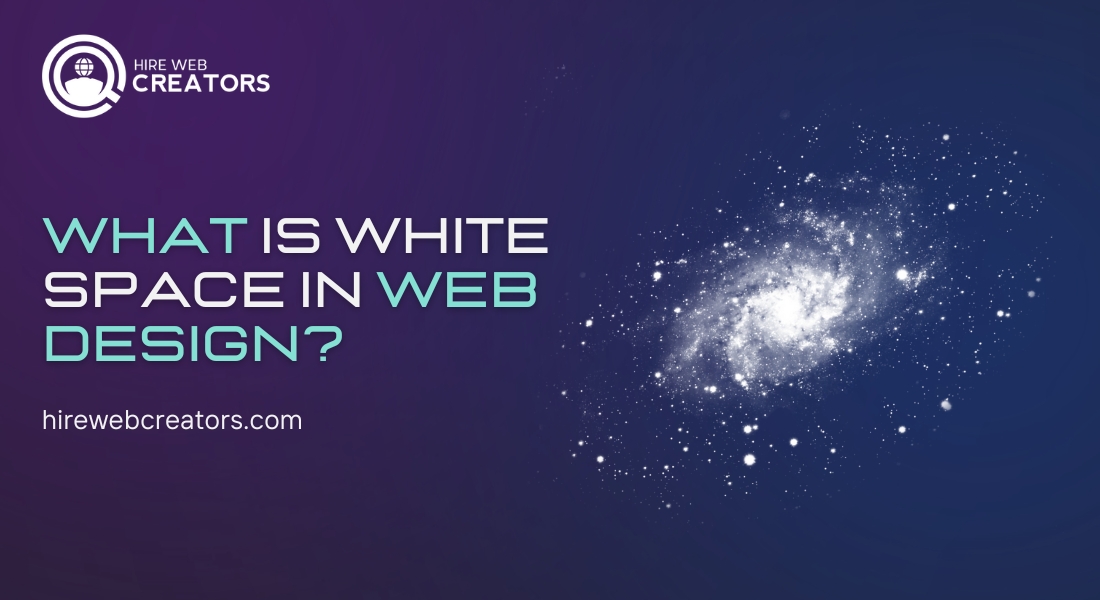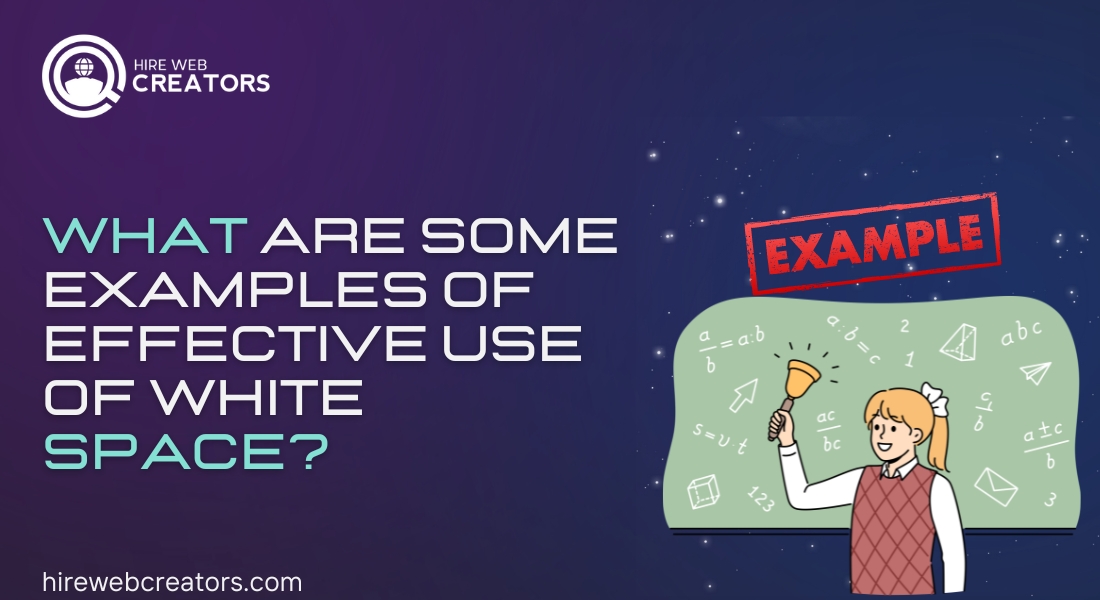

White Space in Web Design: 10 Powerful B2B Strategies
The white space in web design has become an important factor in the competitive landscape of B2B website design for creating both user-friendly and visually appealing user interfaces. It simply means the area around and between design elements, commonly referred to as “negative space.”. Its strategic application not only enhances the aesthetics of a website but also plays a pivotal role in guiding user behavior and improving overall usability.
White space fosters a sense of clarity and organization, making it easier for users to navigate through the content without feeling overwhelmed. By allowing elements to breathe, designers can create a harmonious layout that emphasizes important information and calls to action. Research shows that effective white space can significantly increase user engagement, reduce cognitive load, and ultimately drive conversions.
As B2B companies strive to build a strong online presence, understanding the principles of white space becomes essential. This blog will delve into the multifaceted benefits of white space in web design, explore its impact on user experience, and provide actionable insights for effectively integrating it into your B2B website. By mastering the art of white space, businesses can enhance their digital offerings and foster a deeper connection with their audience.
What is White Space in Web Design?
White space in web design refers to the empty areas surrounding design elements, such as text, images, buttons, and other visual components. Contrary to the common misconception that white space is simply “empty” space, it is a fundamental design element that contributes significantly to the overall aesthetic and functionality of a website. It can be observed in margins, padding, line spacing, and the space between various content blocks. Understanding white space is crucial for B2B web designers, as it plays a vital role in how users perceive and interact with a site.

The effective use of white space in web design helps to create a clean and organized layout, which enhances the overall user experience. By incorporating adequate white space, designers can draw attention to specific content and create a natural flow that guides users through the site. This deliberate spacing can prevent visual clutter, allowing users to focus on key messages and actions without distraction. In a B2B context, where clarity and professionalism are paramount, employing white space effectively can help convey a brand’s values and message more clearly.
White space in web design is instrumental in improving readability and comprehension. Text surrounded by sufficient white space is easier to read and comprehend, reducing cognitive overload for users. This is particularly important for B2B websites, which often present complex information and data. By ensuring that there is ample white space around text elements, designers can facilitate better engagement, making it easier for visitors to absorb the content and take desired actions, such as filling out forms or clicking on calls to action. Thus, mastering the use of white space is essential for creating effective and appealing B2B websites.
Why is White Space Important in B2B Design?
White space in web design is crucial for establishing a visually appealing and functional interface, particularly within the B2B sector. In a digital landscape where businesses compete for attention, the use of white space can set a brand apart by creating an organized and professional appearance. This clean aesthetic not only enhances the visual appeal but also instills a sense of trust and reliability in potential clients. A well-structured layout, accentuated by white space, signals to users that a company values clarity and effective communication.
White space in web design plays a pivotal role in guiding user behavior and decision-making. By strategically placing white space around important elements, such as calls to action or key information, designers can direct users’ attention exactly where it is needed. This intentional spacing helps reduce distractions, making it easier for users to engage with the content and take the desired actions. In the context of B2B websites, where the goal is often to generate leads or facilitate conversions, the thoughtful application of white space can significantly enhance overall performance.
In addition to improving visual hierarchy and user experience, white space in web design contributes to better content legibility. Clear readability is essential when conveying complex information, and white space helps to create a more comfortable reading environment. By ensuring that text is surrounded by adequate white space, designers can minimize cognitive overload, allowing users to absorb and comprehend information more effectively. For B2B companies, presenting information in a digestible format can lead to higher engagement rates and improved user satisfaction, ultimately driving better business outcomes.
How Does White Space Enhance User Experience?
White space in web design is a fundamental component that significantly enhances user experience by creating a sense of balance and harmony throughout a website. By incorporating ample white space, designers can avoid visual clutter, allowing users to navigate more effortlessly. A clean layout, characterized by thoughtful spacing, fosters an intuitive browsing experience, making it easier for users to locate information and understand the content presented. In the B2B context, where users often seek specific information quickly, this clarity can lead to increased satisfaction and prolonged engagement.
White space in web design plays a vital role in optimizing the interaction between users and design elements. When sufficient white space is utilized around buttons and links, it creates a more inviting environment for users to click and explore further. This increased focus on interactive elements can lead to higher conversion rates, which is particularly beneficial for B2B companies aiming to convert website visitors into leads or customers. By enhancing the visibility of these calls to action through strategic use of white space, businesses can guide users toward their desired actions more effectively.
White space in web design contributes to emotional engagement by establishing a modern and sophisticated brand image. A well-designed website that employs white space conveys professionalism and attention to detail, which are crucial qualities in the B2B sector. When users encounter a website that prioritizes clean design and effective use of space, it can foster a positive impression of the brand. This emotional connection is essential for building trust and credibility, ultimately influencing a user’s decision-making process and their likelihood of engaging with the business in the future.
What Are the Types of White Space?
White space in web design can be categorized into two primary types: macro white space and micro white space. Macro white space refers to the larger areas of space that separate major design elements, such as sections, images, and content blocks. This type of white space is crucial for creating a clear and organized layout, as it helps define the overall structure of a page. By utilizing macro white space effectively, designers can guide users’ attention to the most important parts of the website, ensuring a seamless and intuitive navigation experience.

On the other hand, micro white space encompasses the smaller spaces within and between design elements, including margins, padding, and line spacing. This finer level of white space plays an essential role in enhancing readability and improving the visual appeal of text and images. For instance, adjusting line-height or adding padding around buttons can make them more visually appealing and easier to interact with. By carefully considering micro white space, designers can ensure that each element on the page is aesthetically pleasing while also functionally effective, ultimately enriching the overall user experience.
Both types of white space in web design are essential for creating a balanced and professional look that resonates with users, particularly in the B2B sector. A well-designed website that effectively incorporates both macro and micro white space fosters a sense of clarity and sophistication, reflecting the brand’s values and commitment to quality. By understanding and implementing these two types of white space, B2B companies can enhance their online presence, improve user engagement, and drive conversions.
How Can White Space Improve Readability?
White space in web design significantly enhances readability by creating a visually comfortable environment for users. By providing ample space around text elements, designers can prevent overcrowding, allowing readers to focus on the content without distractions. A website that effectively utilizes white space enables users to process information more efficiently, which is crucial in the B2B sector, where clarity and comprehension are essential. When users encounter well-structured text surrounded by appropriate white space, they are more likely to engage with the material and retain the information presented.
White space in web design contributes to better typography and overall visual hierarchy. Proper spacing between lines of text, as well as generous margins and padding around paragraphs, can significantly improve the legibility of written content. When users can easily read and understand the text, they are more inclined to explore further and interact with the website. This is particularly important for B2B companies, which often deal with complex information and detailed specifications. By prioritizing readability through effective use of white space, businesses can ensure that their messages resonate with their target audience.
White space in web design aids in the strategic presentation of information, making it easier for users to skim and scan content. In a world where attention spans are limited, clear separation of text blocks and key points through white space allows users to quickly identify important details. This facilitates a more engaging reading experience, leading to higher retention rates and improved user satisfaction. For B2B websites, where users are frequently seeking specific information or solutions, optimizing readability through white space can have a direct impact on engagement and conversion outcomes.
What Role Does White Space Play in Branding?
White space in web design plays a vital role in shaping a brand’s identity and messaging. By utilizing white space effectively, businesses can create a distinctive visual style that sets them apart from competitors. A clean and uncluttered design communicates professionalism and sophistication, which are essential qualities in the B2B sector. This intentional use of white space allows brands to convey their values and ethos without overwhelming users, fostering a positive first impression that can influence potential clients’ perceptions.
White space in web design enhances brand recognition and recall. When elements are thoughtfully spaced, the design becomes more memorable and easier for users to navigate. By establishing a consistent use of white space across various web pages, companies can create a cohesive brand experience that reinforces their identity. This consistency is crucial in the B2B market, where decision-makers often conduct thorough research before making purchasing choices. A visually appealing and well-structured website can leave a lasting impact, encouraging users to return and engage with the brand further.
White space in web design supports effective storytelling by allowing brands to highlight key messages and elements. By creating breathing room around important content, such as value propositions or testimonials, businesses can guide users’ attention to what truly matters. This strategic use of white space enhances the overall narrative, making it easier for users to grasp the brand’s unique selling points. In the B2B landscape, where conveying complex ideas and solutions is crucial, leveraging white space to support branding efforts can lead to stronger connections with target audiences and improved business outcomes.
How to Balance White Space and Content?
Balancing white space in web design with content is essential for creating an effective and engaging user experience. While white space plays a crucial role in enhancing readability and visual appeal, it is equally important to ensure that there is enough content to deliver the necessary information to users. Achieving this balance involves strategically placing white space around content elements to create a harmonious layout that guides users’ attention without overwhelming them. In the B2B sector, where users often seek detailed information, striking the right balance can significantly impact user satisfaction and engagement.
One effective approach to balancing white space in web design with content is to prioritize essential information and highlight key messages. Designers can achieve this by using ample white space around critical elements, such as headlines, calls to action, and important images. By ensuring that these components are given enough room to stand out, businesses can draw users’ attention to the most relevant content. This approach not only improves usability but also enhances the likelihood of users taking desired actions, such as signing up for newsletters or requesting product demos.
Maintaining a consistent layout throughout the website is key to balancing white space and content effectively. By establishing a grid system and adhering to a consistent spacing strategy, designers can create a cohesive visual structure that facilitates easy navigation. This consistency is crucial in the B2B environment, where users may visit multiple pages during their research process. A well-organized design that seamlessly integrates white space with content allows users to absorb information more naturally, ultimately leading to better engagement and higher conversion rates.
What Common Mistakes Should Be Avoided?
When utilizing white space in web design, several common mistakes can hinder a website’s effectiveness and overall user experience. One of the most significant pitfalls is the overuse of white space, which can create a disjointed and uninviting layout. While white space is essential for clarity and organization, excessive gaps can lead to confusion, as users may struggle to find relevant content. In the B2B sector, where information is often complex, it’s crucial to strike the right balance to ensure that users feel guided rather than lost within the design.

Another mistake to avoid is neglecting the function of white space in web design with content hierarchy. White space in web design should be strategically applied to emphasize important elements and create a clear visual flow. Failing to use white space in web design effectively can result in a cluttered appearance, making it challenging for users to differentiate between primary and secondary information. For B2B websites, where the clear presentation of data is paramount, ensuring that white space in web design reinforces the content hierarchy is essential for maintaining user engagement and enhancing comprehension.
It’s important not to overlook the importance of responsive design when considering white space in web design. As users access websites on various devices, the application of white space in web design must adapt to different screen sizes. Neglecting to optimize white space in web design for mobile and tablet views can lead to poor usability, as elements may appear cramped or misaligned. In the B2B environment, where potential clients may access information on the go, ensuring that white space in web design is consistently applied across all devices is critical for maintaining a professional image and providing a seamless user experience.
How to Use White Space for Effective Call-to-Actions?
White space in web design is a powerful tool for enhancing the effectiveness of call-to-action (CTA) elements. By incorporating adequate white space around CTAs, designers can draw attention to these crucial buttons or links, making them stand out on the page. This deliberate spacing helps to guide users’ focus toward the desired actions, whether it’s signing up for a newsletter, requesting a demo, or making a purchase. In the competitive B2B landscape, where clear action pathways are essential for conversions, leveraging white space can significantly increase the visibility and effectiveness of CTAs.
To optimize white space for effective CTAs, it’s important to ensure that they are not only visually prominent but also intuitively placed within the overall layout. Designers should create a clear visual hierarchy by positioning CTAs in areas with sufficient white space that allows users to easily identify them. For instance, placing a CTA button at the end of a compelling section surrounded by white space can encourage users to take action after engaging with the content. This strategic placement, combined with the effective use of white space, can lead to higher engagement rates and better conversion outcomes for B2B websites.
Using white space effectively can enhance the perceived value of the CTAs. When a button or link is surrounded by ample white space, it conveys a sense of importance and urgency, encouraging users to take the next step. In the B2B sector, where decision-making can often be lengthy and complex, providing users with clear and inviting CTAs through the thoughtful application of white space can help simplify the process. By making these actions more approachable and visually appealing, businesses can significantly improve user engagement and drive better results from their digital marketing efforts.
What Tools Can Help Design with White Space?
Utilizing the right tools is essential for effectively incorporating white space in web design. Design software such as Adobe XD, Sketch, and Figma offers a range of features that enable designers to visualize and manipulate white space with precision. These tools allow for the creation of grids, guidelines, and responsive layouts, making it easier to maintain consistent spacing throughout the design process. For B2B designers, leveraging these tools can enhance the overall user experience by ensuring that white space is strategically applied to improve clarity and organization.

Prototyping tools like InVision and Marvel can assist in evaluating the impact of white space in web design. These platforms enable designers to create interactive prototypes that simulate user interactions, allowing them to test how different white space configurations affect navigation and content engagement. By gathering user feedback on these prototypes, B2B companies can refine their designs to optimize the use of white space, ensuring that it effectively supports user goals and enhances overall usability.
Analytics tools such as Google Analytics and heat mapping software like Hotjar can provide valuable insights into how users interact with white space in web design. By analyzing user behavior and engagement metrics, designers can identify areas where white space may need adjustment or enhancement. This data-driven approach allows B2B companies to make informed decisions about their design strategy, ensuring that white space contributes positively to user experience and helps achieve business objectives. In today’s competitive digital landscape, harnessing these tools can lead to more effective and appealing web designs that resonate with target audiences.
How to Test the Effectiveness of White Space in Design?
Testing the effectiveness of white space in web design is crucial for ensuring that it meets user needs and enhances overall usability. One effective method for evaluating white space is through user testing, where real users interact with the website to provide feedback on their experiences. By observing how users navigate through the design and their interactions with content elements surrounded by white space, designers can gain valuable insights into what works and what doesn’t. This qualitative data is essential for B2B companies looking to refine their web design and create a more user-centric experience.
Another approach to assess the effectiveness of white space in web design is through A/B testing. This method involves creating two versions of a webpage, each with different white space configurations, and measuring user engagement metrics, such as click-through rates and time spent on the page. By comparing these metrics, B2B businesses can determine which design—featuring varying amounts of white space—resonates better with users. A/B testing not only helps identify the optimal amount of white space for specific elements but also informs broader design decisions that can enhance the overall user experience.
Leveraging analytics tools can provide quantitative data on how white space affects user behavior. By analyzing heat maps, scroll depth and conversion rates, designers can evaluate the impact of white space on user engagement. For instance, heat maps can show where users click most frequently and whether ample white space around calls to action leads to higher conversion rates. This data-driven approach enables B2B companies to incorporate AI in B2B web development to make informed design choices that maximize the effectiveness of white space in their web design, ultimately improving user satisfaction and achieving better business results.
What Are Some Examples of Effective Use of White Space?
Examining real-world examples of white space in web design can provide valuable insights into its effective application. Companies like Apple and Airbnb exemplify how strategic use of white space can create visually appealing and user-friendly websites. Apple, in particular, utilizes white space to highlight its products, creating a clean and minimalist aesthetic that draws users’ attention to key features and information. This deliberate spacing enhances the overall user experience and reinforces the brand’s identity as a leader in innovation and design.

Another notable example is Airbnb, which employs white space to create a welcoming and organized layout. By providing ample space around images and text, the site allows users to navigate effortlessly through listings and information. This use of white space not only improves readability but also helps to convey a sense of trust and professionalism, crucial in the B2B sector where users seek reliable services. By showcasing properties in a visually appealing manner, Airbnb effectively engages users, encouraging them to explore further and make bookings.
B2B companies can learn from platforms like Dropbox, which uses white space effectively to simplify complex information. The site utilizes generous spacing around its key features and benefits, making it easy for users to understand the value proposition without feeling overwhelmed. By employing white space thoughtfully, Dropbox enhances user comprehension and navigation, leading to improved engagement and conversion rates. These examples demonstrate the significant impact of white space in web design, illustrating how it can enhance user experience and drive business success across various industries.
How to Incorporate White Space in Your Design Process?
Incorporating white space in the web design process is essential for creating an effective and visually appealing layout. One of the first steps is to establish a grid system, which provides a structured framework for arranging content. By defining clear columns and rows, designers can allocate appropriate amounts of white space around elements, ensuring a balanced and organized appearance. This foundational step helps B2B companies create a consistent layout that enhances usability and guides users’ attention to important content.
Another effective strategy for integrating white space in web design is to prioritize content hierarchy. Designers should identify key messages and actions, allocating more white space around these critical elements to highlight their importance. For example, placing a call-to-action button within a well-defined space can make it stand out and encourage users to engage. By thoughtfully applying white space to emphasize significant content, B2B businesses can create a more intuitive user experience, allowing users to navigate the site with ease.
Continuously reviewing and refining the use of white space during the design process is crucial. Designers should regularly step back and assess the overall layout to ensure that white space is enhancing rather than detracting from the content. Gathering feedback from team members or conducting user testing can provide valuable insights into how white space impacts user interactions. By making adjustments based on this feedback, B2B companies can create a more effective design that leverages white space to improve readability, usability, and overall user satisfaction.
In conclusion, white space in web design is a critical element that significantly influences user experience, readability, and brand perception, especially in the B2B sector. By effectively utilizing white space, designers can create visually appealing layouts that not only enhance usability but also guide users toward important content and actions. The strategic application of white space helps to establish a clean and organized design, making it easier for users to navigate and engage with the site. For B2B companies, where information can be complex, a well-structured design that prioritizes white space can lead to improved comprehension and higher user satisfaction.
The impact of white space extends beyond aesthetics; it plays a vital role in conveying a brand’s identity and values. A website that effectively incorporates white space communicates professionalism and attention to detail, fostering trust and credibility among potential clients. By creating a sense of clarity and sophistication, businesses can differentiate themselves from competitors and establish a strong online presence. In today’s competitive landscape, where first impressions matter, leveraging white space can help B2B companies create a memorable and impactful user experience.
